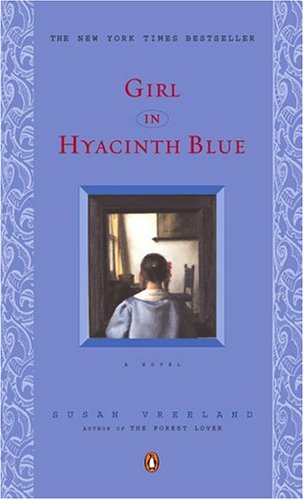There’s very little that piques our interest like a good mystery. . .especially art historical mysteries. Missing works of famous artists referenced in documents throughout history continue to beguile us centuries later. We yearn to know what happened to these lost works: and yet when a supposedly-real one happens to turn up, we’re immediately skeptical so that we won’t be disappointed if it turns out not to be authentic.
Author Susan Vreeland picks up on our art historical curiosity in her 1999 novel “Girl In Hyacinth Blue.” In the book, she weaves together the story of a lost Vermeer painting and the lives it’s affected throughout its lifespan and its provenance. As the book opens, the fictional lost work, aptly titled “Girl In Hyacinth Blue,” is revealed to us through several academic characters. The art expert dismisses it as a fake along the lines of so many Vermeer imitations. . .and yet the painting grips his interest. What if, he wonders, it is real?

Johannes Vermeer’s art appears in our second, third, and sixth-grade curriculum. His body of extant work is limited, and allusions to lost works of his make his work an easy target for forgery. “Girl In Hyacinth Blue” explores the possibility of one of these lost works resurfacing after centuries. . . and then takes readers on a reverse-chronological journey, exploring the painting’s provenance in an attempt to trace it back to the artist himself. As we’re taken back further in time, the work’s true painter becomes clearer and clearer.
Provenance, or the list of previous owners of a work of art that’s often used to determine authenticity, can often be messy, and Vreeland takes readers right into it. The fictional “Girl In Hyacinth Blue” shuffles through the hands of many owners over time; several less than savory. Forcibly taken by Nazis, given as a gift, and sold for money for food, the reasons why “Girl In Hyacinth Blue”‘s provenance is disputed become clearer once we learn its original provenance was left behind when one of its owners sought a quick escape from a failing marriage.
What’s most interesting about “Girl In Hyacinth Blue” is Vreeland’s ability to create a cohesive narrative from the short stories of the painting’s owners. The painting is the link between the many different lives it touches, if not changes. Each person provides a different perspective on the painting, and all are in awe of its artistic beauty.
“Girl In Hyacinth Blue” is definitely worth a read for any fan of Vermeer, or for anyone interested in how art can change lives. It’s also an interesting and accessible study in provenance that never becomes pretentious. At heart, it’s a story of a fictional painting that manages to outlive the hands it’s passed through and continues to inspire many more over time: and that’s something we can all celebrate.
Read more about Susan Vreeland and “Girl In Hyacinth Blue” here.
What do we do here at the Art Docent Program? Discover more about us and our curriculum here!
Want to read more about Vermeer and other artists? Check out our blog archives!
Don’t forget to follow us on Facebook for more!







